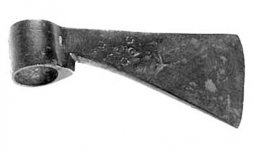Navigation
Install the app
How to install the app on iOS
Follow along with the video below to see how to install our site as a web app on your home screen.
Note: This feature may not be available in some browsers.
More options
You are using an out of date browser. It may not display this or other websites correctly.
You should upgrade or use an alternative browser.
You should upgrade or use an alternative browser.
Trade Axe Makers Mark
- Thread starter WawaDuane
- Start date
nhbenz
Gold Member
The "Brades Co. Cast Steel" mark appears to put it in the 1800's, from items I find online. Here is a discussion of some folks that researched the company history a bit: OldTools Archive -- thread with message 144803
Upvote
0
WawaDuane
Sr. Member
- Oct 12, 2013
- 393
- 1,624
- 🏆 Honorable Mentions:
- 1
- Detector(s) used
- Garrett At Pro International
- Primary Interest:
- Metal Detecting
- Thread starter
- #4
If I may ask... did you dig this up yourself, or was it purchased somewhere along the way?
Nope I dug it up myself at a very old site here that dates in the 1700's.
Upvote
0

 View attachment 1758452[/ATTACH]
View attachment 1758452[/ATTACH]
I think my axe is similar to yours mine looks like there is a makers mark just about the bit but it isn't very visible I think I see a quadrilateral outline. This is slip fit eye as well.

Last edited:
Upvote
0
Here is an example of 17th–century trade ax, typically made in northern Spain and traded by the French with American Indians.
I get the impression that your axe head dates to the early 19thc.
"Part of the problem of focusing attention on the American/Canadian axe arises from the fact that the earliest ones used here were made in Europe, and certainly the first ones made here were European in character. Thus, in the earliest colonial times a dividing line could not be drawn between the two categories. As a matter of fact, the object was really a European–American axe. Because iron, unlike wood, is similar regardless of the place it was made, the essential substance of an axe does not help to identify its origin. Short of some identifiable maker's mark, the manufacturers of most of our early axes must remain anonymous.
It seems certain that most of the first axes made in North America were made and used on the Atlantic seaboard, a few exceptions occurring when trading companies brought in blacksmiths to their centers of exchange to repair and resharpen axes. As settlers moved westward and southward, their needs were supplied by smiths who went with them and were responsive to individual needs. This procedure was the beginning of very high specialization in the forms of axes, a differentiation which was picked up by the big manufacturers in the nineteenth century. The axes were mostly of the felling variety, but there were other purposes for which an axe was needed.
The pace of specialization increased; as evidence of this trend, one manufacturer informed the writer that at one time the company manufactured about three hundred different types. The president of the Mann Edge Tool Company, in Lewistown, Pennsylvania, reported that in 1969 they were producing seventy different patterns; however, the bulk of their production involved only about twenty. The ax became quite specialized in Europe during the Middle Ages and afterward. When European colonists dispersed throughout the New World, they brought their tools and their knowledge with them."
Nice find Duane,
Dave
I get the impression that your axe head dates to the early 19thc.
"Part of the problem of focusing attention on the American/Canadian axe arises from the fact that the earliest ones used here were made in Europe, and certainly the first ones made here were European in character. Thus, in the earliest colonial times a dividing line could not be drawn between the two categories. As a matter of fact, the object was really a European–American axe. Because iron, unlike wood, is similar regardless of the place it was made, the essential substance of an axe does not help to identify its origin. Short of some identifiable maker's mark, the manufacturers of most of our early axes must remain anonymous.
It seems certain that most of the first axes made in North America were made and used on the Atlantic seaboard, a few exceptions occurring when trading companies brought in blacksmiths to their centers of exchange to repair and resharpen axes. As settlers moved westward and southward, their needs were supplied by smiths who went with them and were responsive to individual needs. This procedure was the beginning of very high specialization in the forms of axes, a differentiation which was picked up by the big manufacturers in the nineteenth century. The axes were mostly of the felling variety, but there were other purposes for which an axe was needed.
The pace of specialization increased; as evidence of this trend, one manufacturer informed the writer that at one time the company manufactured about three hundred different types. The president of the Mann Edge Tool Company, in Lewistown, Pennsylvania, reported that in 1969 they were producing seventy different patterns; however, the bulk of their production involved only about twenty. The ax became quite specialized in Europe during the Middle Ages and afterward. When European colonists dispersed throughout the New World, they brought their tools and their knowledge with them."
Nice find Duane,

Dave
Attachments
Upvote
0
Top Member Reactions
-
 3480
3480 -
 1986
1986 -
 1912
1912 -
 1160
1160 -
 1090
1090 -
 1010
1010 -
 889
889 -
 864
864 -
 860
860 -
 795
795 -
 759
759 -
 676
676 -
 659
659 -
 567
567 -
 508
508 -
 453
453 -
 447
447 -
 410
410 -
 401
401 -
E
398
Users who are viewing this thread
Total: 2 (members: 0, guests: 2)







